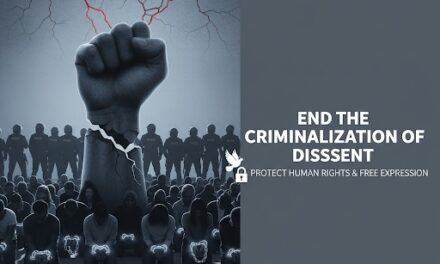Grim Picture of Human Rights in India. Courtesy The Seoul Times
Toronto, June 26th 2010: What has India got to hide? Despite claiming to be the world’s largest democracy, India continues to engage in acts which are an insult to the very notion of human rights. Under the reign of impunity, human rights abuses continue to take place to this day. In recognition of the International Day in Support of Victims of Torture, Voices For Freedom would like to bring to attention to India’s shameful record of torture.
On 21 August 2009, Karnail Singh (45 years), resident of Hazarsingh Wala village in Mamdot, died as a result of alleged torture in police custody, at the Guruharsahai Police Station, in Ferozepur district of Punjab. Mr Singh was picked by a police team from his residence following a complaint over a monetary dispute. The police claimed that Karnail Singh was unwell and died as a result of nervousness. However, Sheelo Rani, the victim’s sister, alleged that her brother was tortured to death by the police.[1] — ACHR’s complaint to National Human Rights Commission. ACHR’s Reference o: PN/15/2009
Karnail Singh’s case is one of thousands in India. Thus, it is no surprise that after 13 years since India signed on to the United Nation’s Convention Against Torture and Other Cruel, Inhuman or Degrading Treatment or Punishment (CAT), India has still not ratified the treaty. Even as a signatory, India has a responsibility to refrain from acting in a manner that undermines the object and purpose of the Convention. Unfortunately, India’s reign of impunity has been ongoing for decades and shows no signs of ceasing.
India’s refusal to sign the Optional Protocol to the Convention against Torture and Other Cruel, Inhuman or Degrading Treatment or Punishment is further proof of its non-committal attitude towards the preservation of human rights. According to the Asian Centre for Human Rights (an organization funded by the European Commission), from 1999-2009, 1,511 deaths by means of police torture have been reported in India. Even if cases are investigated, minor officers may be sanctioned while senior officers are left unchecked to continue their pattern of abuse. With ever increasing degrees of impunity, justice for victims of torture is an ephemeral dream – a sad commentary for the so called largest “democracy” in the world.
The Supreme Court of India itself has recognized the prevalence of torture by state officials in India:
“Nothing is more cowardly and unconscionable than a person in police custody being beaten up and nothing inflicts a deeper wound on our constitutional culture than a State official running berserk regardless of human rights. Article 21, with its profound concern for life and limb, will become dysfunctional unless the agencies of the law in police and prison establishments have sympathy for the humanist creed of that article instead of a rough treatment by police for getting information or confession.” – Supreme Court of India[2]
While section 24 of the Evidence Act of India states that confessions made under torture to be inadmissible as evidence, torture has been, and is to this day, used to extract confessions from suspects in India. While some of these cases result in death, many do not. There is virtually no official monitoring of the Indian police forces, as they are not required to report any deaths in their custody to the National Human Rights Commission.[3] Therefore, torture has been used as a means to mask intimidation of minority communities while silencing their dissent.
But apart from being used to extract confessions, torture is also used on individuals who are unable to pay bribes. Seemingly irrelevant in many cases of torture and cruel, inhumane or degrading treatment is the victims’ age or gender.
In June 2009, two railway police officials were arrested for throwing a pregnant woman and her three year old daughter off of a moving train for not paying a bribe of Rs 100 (~ $2.25 CAD).[4]
In August 2009, a 15 year old juvenile named Rohit was illegally detained at the police station of Faizabad district of Uttar Pradesh in connection with the theft of a mobile phone. The victim was allegedly subject to third degree torture including electric shocks to obtain a confession. The police had allegedly asked the minor’s father to pay Rs 30,000 failing which Rohit was continued to be detained and tortured. Because of torture Rohit lost his eye sight and was vision-less for six months until he got back his vision after treatment.[5]
Only now, menial efforts are being made to help victims of torture. On April 8, 2010, the Indian government introduced a Prevention of Torture Bill before parliament and proposed to ratify the CAT. Yet, this bill is being treated as a secret document.[6]
Torture prevention must be a priority for India. It is imperative that stringent laws on prevention, accountability, and compensation are enacted. If India wants to be considered the world’s largest democracy, India has a duty to both its own citizens and to the international community. It must take preventative measures to ensure that the crime of torture is prevented, and that the perpetrators are given due process of law, which they themselves have denied to others.
Dr Sudip Minhas
Voices For Human Rights-Canada
P: 1-519-982-0210
[1] Asian Centre for Human Rights’ Complaint to NHRC, 25 August 2009, ACHR’s Reference: PN/15/2009.
[2] (AIR 1981 SC 625).
[3] Page 23, Torture in India 2010. Asian Centre for Human Rights, 2010.
[4] Indian police ‘threw pregnant mother from train for failing to pay bribe’, Telegraph, UK, 21 Jun 2009, http://www.telegraph.co.uk/news/worldnews/asia/india/5595299/Indian-policethrew-
pregnant-mother-from-train-for-failing-to-pay-bribe.html.
[5] After 6 months, tortured youth gets vision back. The Indian Express, 28 December 2009
[6] Torture in India 2010. Asian Centre for Human Rights, 2010.




